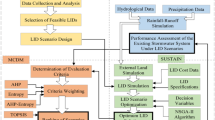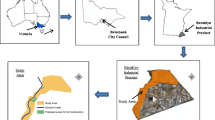Abstract
The changes of land surface characteristics due to urbanization lead to various environmental problems such as increasing the runoff which can lead to flooding and the poor quality of receiving waters. Among different land uses in urban areas, the industrial areas are highly environmentally degraded land areas which annually discharge high amounts of contaminated stormwater to natural waterways. However, industrial areas plays major role in a country’s economy and therefore it is important to identify optimum strategies to improve the quality of runoff in such areas. Green Infrastructure (GI) practices integrate measures to restore the green space in urban areas and are currently becoming one of the promising strategies around the world as source control measures of stormwater, especially when implemented as treatment trains. For a complex land use like an industrial area, the reality in optimizing GI treatment trains can incorporate several aspects related to environmental, economic and social objectives which are expected of GI through their implementation. The Technique for Order of Preference by Similarity to Ideal Solution (TOPSIS) was used in this study to identify compromise optimum treatment train configurations and the sizing combinations of GI treatment trains for a case study industrial area in Melbourne, Australia. Moreover, a sensitivity analysis was performed to validate the results obtained through TOPSIS by considering several weighting schemes for different performance measures. The results of the sensitivity analysis assessed the most sensitive performance measures for the weight changes. The methodology proposed in this study was successful in optimizing both the selection and sizing of a GI treatment train for an industrial area simultaneously.




Similar content being viewed by others
References
Ahiablame LM, Engel BA, Chaubey I (2012) Effectiveness of low impact development practices: literature review and suggestions for future research. Water Air Soil Pollut 223:4253–4273
Ananda J, Herath G (2009) A critical review of multi-criteria decision making methods with special reference to forest management and planning. Ecol Econ 68:2535–2548
Ascough J, Maier H, Ravalico J, Strudley M (2008) Future research challenges for incorporation of uncertainty in environmental and ecological decision-making. Ecol Model 219:383–399
Browne D, Brookes K (2014) Living Brooklyn integrated water cycle management strategy. E2 Design Lab, Melbourne
Elliott A, Trowsdale S (2007) A review of models for low impact urban stormwater drainage. Environ Model Softw 22:394–405
Ellis JB, Deutsch J-C, Mouchel J-M, Scholes L, Revitt M (2004) Multicriteria decision approaches to support sustainable drainage options for the treatment of highway and urban runoff. Sci Total Environ 334:251–260
Herath G, Prato T (2006) Role of multi-criteria decision making in natural resource management. Using multi-criteria decision analysis in natural resource management. Ashgate, Burlington, pp 1–10
Huang IB, Keisler J, Linkov I (2011) Multi-criteria decision analysis in environmental sciences: ten years of applications and trends. Sci Total Environ 409(19):3578–3594
Hwang CL, Yoon K (1981) Muliple attributes decision making methods and applications and applications. Springer, Berlin
Insua DR (1990) Sensitivity analysis in multi-objective decision making. Sensitivity Analysis in Multi-objective Decision Making. Springer
Jahanshahloo GR, Lotfi FH, Izadikhah M (2006) An algorithmic method to extend TOPSIS for decision-making problems with interval data. Appl Math Comput 175:1375–1384
Jayasooriya VM, NG AWM (2014) Tools for modeling of stormwater management and economics of green infrastructure practices: a review. Water Air Soil Pollut 225(8):2055
Jayasooriya V, NG A, Muthukumaran S, Perera B (2016) Optimal Sizing of Green Infrastructure Treatment Trains for Stormwater Management. Water Resour Manag 30:5407–5420
Jia H, Yao H, Tang Y, Shaw LY, Zhen JX, Lu Y (2013) Development of a multi-criteria index ranking system for urban runoff best management practices (BMPs) selection. Environ Monit Assess 185:7915–7933
Jones R, Ooi D (2014) Living Brooklyn: baseline report on the economics of the urban water cycle in the Brooklyn industrial precinct. Victoria Institute of Strategic Economic Studies: Victoria University, Melbourne
Kaini P, Artita K, Nicklow JW (2007) Evaluating optimal detention pond locations at a watershed scale. In: Kabbes KC (ed) World environmental and water resources congress 2007: restoring our natural habitat. ASCE, Reston, pp 1–8
Kaini P, Artita K, Nicklow JW (2012) Optimizing structural best management practices using SWAT and genetic algorithm to improve water quality goals. Water Resour Manag 26:1827–1845
Kiker GA, Bridges TS, Varghese A, Seager TP, Linkov I (2005) Application of multicriteria decision analysis in environmental decision making. Integr Environ Assess Manag 1:95–108
Kodikara PN (2008) Multi-objective optimal operation of urban water supply systems. Doctoral dissertation, Victoria University, Melbourne
Mareschal B (1986) Stochastic multicriteria decision making and uncertainty. Eur J Oper Res 26:58–64
Martin C, Ruperd Y, Legret M (2007) Urban stormwater drainage management: The development of a multicriteria decision aid approach for best management practices. Eur J Oper Res 181:338–349
Milani A, Shanian A, Madoliat R, Nemes J (2005) The effect of normalization norms in multiple attribute decision making models: a case study in gear material selection. Struct Multidiscip Optim 29:312–318
Montaseri M, Afshar MH, Bozorg-Haddad O (2015) Development of Simulation-Optimization Model (MUSIC-GA) for Urban Stormwater Management. Water Resour Manag 29:4649–4665
Munda G, Nijkamp P, Rietveld P (1994) Qualitative multicriteria evaluation for environmental management. Ecol Econ 10:97–112
River Health Data (2014) Melbourne Water. Available: http://www.melbournewater.com.au/waterdata/riverhealthdata/werribee/Pages/Werribee-catchment.aspx [Accessed 25th June 2016]
Roy B (1968) Classement et choix en présence de points de vue multiples. Revue française d'automatique, d'informatique et de recherche opérationnelle. Recherche opérationnelle 2:57–75
Shih H-S, Shyur H-J, Lee ES (2007) An extension of TOPSIS for group decision making. Math Comput Model 45:801–813
Steele K, Carmel Y, Cross J, Wilcox C (2009) Uses and misuses of multicriteria decision analysis (MCDA) in environmental decision making. Risk Anal 29:26–33
The Brooklyn Evolution (2012) Brooklyn industrial precinct strategy. Brimbank City Council, Victoria
Triantaphyllou E, Sánchez A (1997) A sensitivity analysis approach for some deterministic multi-criteria decision-making methods. Decis Sci 28:151–194
Wang J-J, Jing Y-Y, Zhang C-F, Zhao J-H (2009) Review on multi-criteria decision analysis aid in sustainable energy decision-making. Renew Sust Energ Rev 13:2263–2278
Wang TC, Lee HD (2009) Developing a fuzzy TOPSIS approach based on subjective weights and objective weights. Expert Syst Appl 36(5):8980–8985
Yoon KP, Hwang CL (1995) Multiple attribute decision making: an introduction, vol 104. Sage Publications, Thousand Oaks
Young KD, Younos T, Dymond RL, Kibler DF, Lee DH (2010) Application of the analytic hierarchy process for selecting and modeling stormwater best management practices. Journal of Contemporary Water Research & Education 146:50–63
Zanakis SH, Solomon A, Wishart N, Dublish S (1998) Multi-attribute decision making: A simulation comparison of select methods. Eur J Oper Res 107:507–529
Author information
Authors and Affiliations
Corresponding author
Rights and permissions
About this article
Cite this article
Jayasooriya, V.M., Muthukumaran, S., Ng, A.W.M. et al. Multi Criteria Decision Making in Selecting Stormwater Management Green Infrastructure for Industrial areas Part 2: A Case Study with TOPSIS. Water Resour Manage 32, 4297–4312 (2018). https://doi.org/10.1007/s11269-018-2052-z
Received:
Accepted:
Published:
Issue Date:
DOI: https://doi.org/10.1007/s11269-018-2052-z




